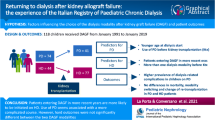Abstract
Background
Kidney transplant is the renal replacement therapy (RRT) of choice for children with end stage kidney disease (ESKD). Only 21.3% of children who initiate RRT receive a preemptive kidney transplant (PKT). We characterized the transition to RRT in children in the CKiD cohort including the prevalence of dialysis as first RRT vs. PKT and graft survival.
Methods
258 children enrolled in CKiD have initiated RRT, and 202 had post-RRT initiation data collected through phone or in-person follow-up. Characteristics by first RRT modality were compared using Chi-square and Kruskal-Wallis tests. Parametric-accelerated failure time models were fit for transplantation. Graft failure was characterized using Kaplan-Meier methods and log rank tests.
Results
Sixty-one percent received dialysis as first RRT modality and 39% PKT. Those with PKT were less likely to have glomerular disease and to be African-American, and had higher household-income. African-American subjects were nearly twice as likely to undergo dialysis prior to transplant. Those with a living donor and a college-educated mother had 40%-decreased odds of being dialysis experienced. Children with PKT were more likely to receive a living donor transplant. Only 5% of PKT subjects had graft failure by 4 years compared to 16% of those initially treated with dialysis (p = 0.092); however, after adjustment the effect of dialysis exposure was attenuated (p = 0.206).
Conclusion
CKiD subjects undergo PKT more often compared to nationally-reported rates, and are more likely to receive a kidney transplant within 1 year of starting dialysis. African-American race and lower household-income are associated with decreased access to PKT.


Similar content being viewed by others
Change history
02 March 2020
The original version of this article unfortunately contained a mistake
References
Goto N, Okada T, Yamamoto T et al (2016) Association of dialysis duration with outcomes after transplantation in a Japanese cohort. Clin J Am Soc Nephrol 11(3):497–504
Mange KC, Joffe MM, Feldman HI (2001) Effect of the use or nonuse of long-term Dialysis on the subsequent survival of renal transplants from living donors. N Engl J Med 344(10):726–731
Amaral S, Sayed BA, Kutner N, Patzer RE (2016) Preemptive kidney transplantation is associated with survival benefits among pediatric patients with end-stage renal disease. Kidney Int 90(5):100–1108
Liem YS, Weimar W (2009) Early living-donor kidney transplantation: a review of the associated survival benefit. Transplantation 87(3):317–318
Kallab S, Bassil N, Esposito L, Cardeau-Desangles I, Rostaing L, Kamar N (2010) Indications for and barriers to preemptive kidney transplantation: a review. Transplant Proc 42(3):782–784
2018 USRDS Annual Data Report: Executive Summary (2019) Am J Kidney Dis. https://www.usrds.org/adr.aspx
Flom LS, Reisman EM, Donovan JM, Zaontz MR, Stein J, Firlit CF, Cohn RA (1992) Favorable experience with pre-emptive renal transplantation in children. Pediatr Nephrol 6(3):258–261
Nevins TE, Danielson G (1991) Prior dialysis does not affect the outcome of pediatric renal transplantation. Pediatr Nephrol 5(2):211–214
Vats AN, Donaldson L, Fine RN, Chavers BM (2000) Pretransplant dialysis status and outcome of renal, transplantation in north American children: a NAPRTCS study. Transplantation 69(7):1414–1419
Patzer RE, Sayed BA, Kutner N, McClellan WM, Amaral S (2013) Racial and ethnic differences in pediatric access to preemptive kidney transplantation in the United States. Am J Transplant 13(7):1769–1781
Furth SL, Cole SR, Moxey-Mims M et al (2006) Design and methods of the chronic kidney disease in children (CKiD) prospective cohort study. Clin J Am Soc Nephrol 1(5):1006–1015
Schwartz GJ, Schneider MF, Maier PS, Moxey-Mims M et al (2012) Improved equations estimating GFR in children with chronic kidney disease using an immunonephelometric determination of cystatin C. Kidney Int 82(4):445–453
Cox C, Chu H, Schneider MF, Muñoz A (2007) Parametic survival analysis and taxonomy of hazard functions for the generalized gamma distribution. Stat Med 26(23):4352–4574
Warady BA, Abraham AG, Schwartz GJ, Wong CS, Muñoz A, Betoko A, Mitsnefes M, Kaskel F, Greembaum LA, Mak RH, Flynn J, Moxey-Mims MM, Furth S (2015) Predictors of rapid progression of glomerular and nonglomerular kidney disease in children and adolescents: the chronic kidney disease in children (CKiD) cohort. Am J Kidney Dis 65(6):878–888
Chavers BM, Solid CA, Daniels FX et al (2009) Hypertension in pediatric long-term hemodialysis patients in the United States. Clin J Am Soc Nephrol 4(8):1363–1369
Shamszad P, Slesnick TC , Smith EOB, Taylor MD, Feig (2012) Association between left ventricular mass index and cardiac function in pediatric dialysis patients. Pediatr Nephrol 27(5):835–841
Arbeiter AK, Büscher R, Petersenn S, Hauffa BP, Mann K, Hoyer PF (2009) Ghrelin and other appetite-regulating hormones in paediatric patients with chronic renal failure during dialysis and following kidney transplantation. Nephrol Dial Transplant 24(2):643–646
Nissel R, Lindberg A, Mehls O, HaffnerD (2008) Factors predicting the near-final height in growth hormone-treated children and adolescents with chronic kidney disease. J Clin Endocrinol Metab 93(4):1359–1365
Rasbury WC, Fennell RS III, Fennell EB, Morris MK (1986) Cognitive functioning in children with end stage renal disease pre- and post-dialysis session. Int J Pediatr Nephrol 7(1):45–50
United States Renal Data System (2014) Annual data report: epidemiology of kidney disease in the United States. National Institutes of Health, National Institute of Diabetes and Digestive and Kidney Diseases, Bethesda, MD
USRDS (2017) 2017 USRDS Annual Data Report: Executive Summary. https://www.usrds.org/2017/view/Default.aspx
Funding
The CKiD study is funded by the National Institute of Diabetes and Digestive and Kidney Diseases with additional funding from the Eunice Kennedy Shriver National Institute of Child Health and Human Development and the National Heart, Lung, and Blood Institute (UO1-DK-66143, UO1-DK-66174, U01-DK-082194, and UO1-DK66116).
Author information
Authors and Affiliations
Contributions
Research idea and study design: MA, JR, AG, AM; data acquisition: JR, AG, AM; Data analysis/interpretation: MA, JR, AG, BW, SF, AM; Statistical analysis: JR, AM; Supervision or mentorship: BW, SF, AM. Each author contributed important intellectual content during manuscript drafting or revision and accepts accountability for the overall work by ensuring that questions pertaining the accuracy or integrity of any portion of the work are appropriately investigated and resolved.
Corresponding author
Ethics declarations
Conflict of interest
The authors declare that they have no conflict of interest.
Additional information
Publisher’s note
Springer Nature remains neutral with regard to jurisdictional claims in published maps and institutional affiliations.
The original version of this article was revised: Figures 1 and 2 contained undesired lines as a result of reproduction. Both figures were corrected.
Rights and permissions
About this article
Cite this article
Atkinson, M.A., Roem, J.L., Gajjar, A. et al. Mode of initial renal replacement therapy and transplant outcomes in the chronic kidney disease in children (CKiD) study. Pediatr Nephrol 35, 1015–1021 (2020). https://doi.org/10.1007/s00467-019-04416-2
Received:
Revised:
Accepted:
Published:
Issue Date:
DOI: https://doi.org/10.1007/s00467-019-04416-2




